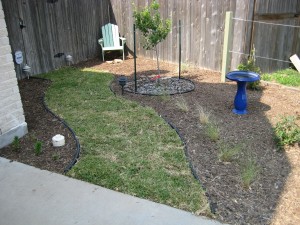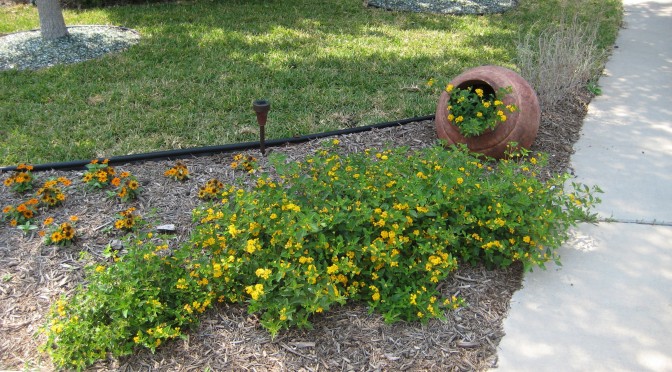Here in Texas, if you’ve been waiting, and hoping, for your lawn to start growing this spring and return to its former lush green splendor, it’s probably safe to say that if it hasn’t started growing yet then it’s just not going to happen. Last summer’s record breaking temperatures, the severe drought we are still facing, and the watering restrictions most of us are still under have combined to make this a very difficult time to maintain a lawn in Texas and many other areas of the country.
Turfgrass covers almost 2 million acres of land in the state of Texas. It’s unclear exactly how many lawns died, but the Texas Forest Service recently reported that some 5.6 million urban shade trees were killed by our record drought last year.
Options
If your lawn is one of the many to have died, you basically have three options available to you besides leaving what once was your lawn in its current state as a sort of tribute to the dust bowl. Restore it to its previous state with new sod or seed. Replace it entirely with non-turgrass alternatives such as gravel, mulched beds, or patios and pathways. Or you can reduce it by incorporating areas of mulched beds and hardscape into your yard along with a smaller amount of turfgrass. Look at this as an opportunity to rethink your entire home landscape design and modify it to not only save water, money, and maintenance time, but to make it look the way you always wanted it to look.
Make a Plan
Start by making a diagram of your landscape and garden plan. If you have the original survey from when you bought your house, make a copy of it and use that as a starting point. If not, just make a rough sketch of the footprint of your home. Draw in existing landscape features, and planned lawn and garden areas. Indicate which way is north and make note of any shady or poorly drained areas.
When planning new landscape, it’s sometimes easier to go back out in your yard and envision your ideas where you may want to put them. Remember to not just consider how existing trees and shrubs look now, but how they will look when they get larger and more mature. Decide which views and nearby sounds you what to screen, and which views you want to accentuate. Take into account each window that looks out onto your yard and place an attractive view, or privacy screen as needed.
Make it Fit Your Needs
Think about what you will be doing in your yard. If you have young children and pets you will need more open lawn. If the kids are grown and you are a gardener, then plan for more space to grow vegetables and flowers. Decide how much time and effort you want to put into maintaining your landscape. Plan for a more elaborate landscape design if you really enjoy working in the yard. To minimize maintenance, consider a simple landscape design utilizing smaller lawn areas, more mulched areas, native plants, pathways for heavily traveled areas, borders around beds, the use of more perennials and less annual flowers, flowering trees and shrubs for color, and an irrigation system. Lay a garden hose on the ground in the shape of a proposed bed to help get a better idea of how it will look.
Choose Plants and Turfgrass
When choosing plants, consider their sunlight and moisture requirements and group plants with similar requirements together. Think about each plant’s form, texture, and growth habit both when new and as it matures and also throughout each season. It’s always a good idea to have some seasonal interest in the yard all year long.
 Plan where you want to have a lawn. Just as important as choosing the right plants for your yard, is choosing the right type of turfgrass. The main choices available to our area are St Augustine, Bermuda, Buffalo, and Zoysia grasses. Each type has both positive and negative characteristics, and many varieties to choose from.
Plan where you want to have a lawn. Just as important as choosing the right plants for your yard, is choosing the right type of turfgrass. The main choices available to our area are St Augustine, Bermuda, Buffalo, and Zoysia grasses. Each type has both positive and negative characteristics, and many varieties to choose from.
Don’t Worry
At this point, the thrill of coming up with a new landscape design is probably slowly being replaced with the dread of the time, money, and effort it will take to complete the entire project. It’s always a good idea to make a master landscape plan for your entire yard, but that doesn’t mean that you have to do it all at once. Start with a small area, and as time, finances, and weather permit gradually chip away. Enjoy yourself, and get help when you need it.
In my next post we’ll take a detailed look at selecting, planting, and caring for each type of turfgrass, and how to bring all of the pieces together to take your landscape plan from paper to the soil of your yard. So for now, get out there and make your landscape plan. By making a plan, choosing the right plants, trees, and turfgrass, and taking it one chunk at a time, you can achieve that coveted “Yard of the Month” sign, plant and grow enough vegetables to feed your family, or just lower the amount of time you need to spend working in your yard. It’s up to you… but I’ll be here to help.


